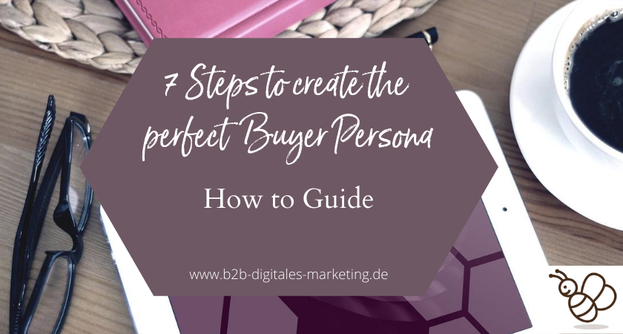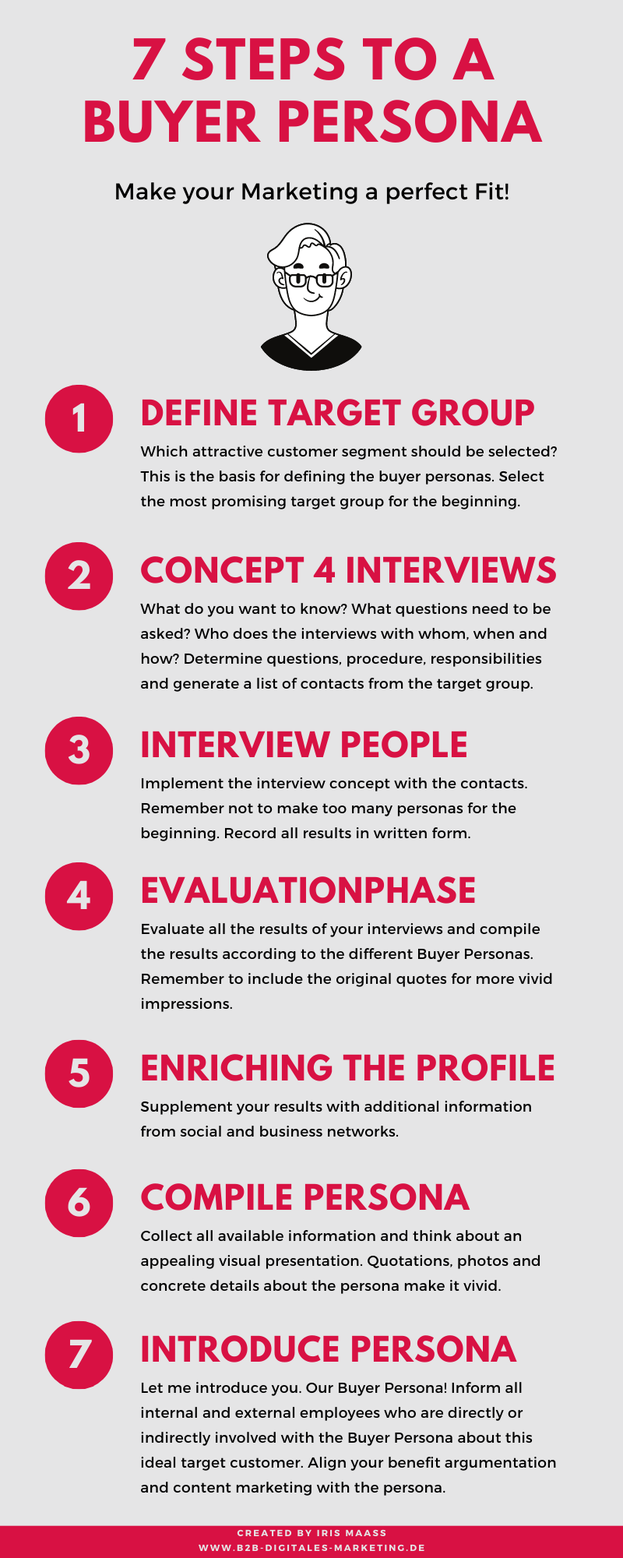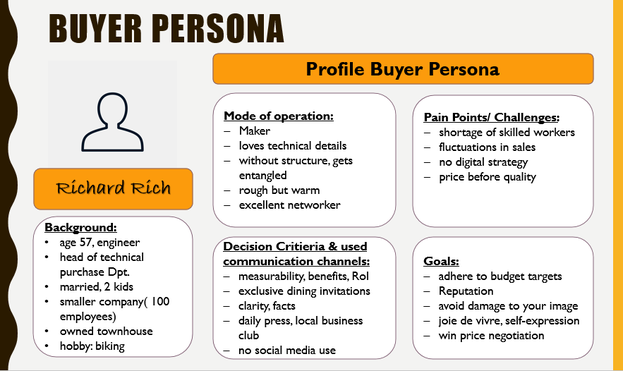
The task of marketing is to understand people and to align the measures with the needs of the users. In order to achieve this, a Buyer Persona is developed for all important people involved in the investment decision process. The seven steps to develop the Buyer Persona are shown in the graphic below.

Buying Center in B2B
Personas are like a strategic navigator that ensures that your digital marketing efforts are targeted at specific people. They are the decisive factor for communication and bring your desired target group to the point. When it comes to possible innovations, the persona is your polar star. It helps you to develop towards customer needs. In B2B business, you will always have a number of personas for a product or service, as usually a whole group of people in the customer company decides on the purchase. Possible roles are for example the following:
The decision maker: a member of top management who ultimately makes the purchase decision from his budget. He is risk-averse and does not want to make a mistake.
The decision maker: This can be a staff position under the decision maker or a person from the specialist department who has registered the need for the product.
The purchasing department: It obtains various offers, ensures that the planned processes are adhered to. It is important to him to buy the product at the lowest possible price.
The users of your product or service: They should work with the product later. If you do not like it, the project fails.
The influencers: Influencers in the Group can be the levels above the management, since, for example, specifications of the board of directors must be taken into account. IT, the data protection officer, quality manager or the works council can also play a role here. That depends on your business area.

Step 1: Definition of target group segments
Already with one product you quickly come up with three or more personas that you need to consider in terms of content. Therefore, please select only one of your products for the beginning. Define for this few but attractive target group segments. For the sale of sheet metal stamping, for example, the most diverse economic sectors can be target group segments: Plant constructors, architects, agricultural machinery manufacturers, the mining industry and many more. Based on your previous experience or market analyses, select the most important area for you in the future. Even if your target group segment for the sheet metal stamping industry in question initially concentrates only on the manufacturers of sheet metal for the food industry, you will have enough material here for possible buyer personas. Manufacturers of baking oven trays or vibrating screens, of sorting systems for the food industry or of packaging systems are possible.
Step 2: Create interview concept for Buyer Persona
The second step is whether you have a good understanding of where the attention of the users you want to reach is located. Do you understand which texts and images, audios and videos you need to use to attract users' attention? In this step you identify the user requirements and research intentions, problems, needs, motivations, fears, possible objections, influencing conditions, behaviour, expectations and interests. For this purpose, you create an interview concept with corresponding questions. In addition to information about the person and position, you ask about
- current challenges in the industry,
- about the three biggest problems that arise in relation to work.
- Where does the person obtain your information from and on which platforms, media or congresses does he or she obtain information.
It is best to collect all possible questions that you would like to ask your target persons and which they would like to have answered with regard to a tailor-made marketing strategy. For example, if you want to contact people about LinkedIn, then take this as a question for your interview concept:
- Are you represented on LinkedIn?
- In which forums are you active there?
Ask existing customers about the general conditions under which the contact person decided on their own product.
Step 3: Conducting personal interviews
When you have worked out the interviews, discuss it with your sales department or other employees to make sure it fits. And then consider which contacts they have that they can interview about it. I recommend that the interviews be conducted by one or two people who have a good feel for people. Take 5-10 interviews per person. If you can do more and want a broader information base for your product or service, then do more interviews. The target persons can be contacts on the side of existing customers or potential customers who have recently joined you through sales or other channels. Make sure that you only select contacts that match the circles you selected in step one. An interview can take up to 30 minutes. This depends on how talkative your counterpart is. Ask politely and present your request. In my experience, B2B contacts are generally willing to invest the time for you. It is in the interest of your customers to be prepared for them. If someone does not have time or is not interested in the interview, then thank them and find another contact.
But: Do not skip this important point. This is your field research. When working with an agency, a lot of effort is put into researching the buyer personas. If you do it yourself, you can use a slimmed-down concept like the one I suggested, but you should not do without it or base it only on internal assessments. It is the basis for all your subsequent marketing strategies and measures. Do not rely on the opinions of your own employees. Do your own primary research. It will surprise them what they learn there about your desired customers, what they did not know yet.
If you would like to consider the expectations of your employees or partners - consultants for example - then create your own interview concept for them
Step 4: Evaluation of the Interviews
After the interviews, these must be transcribed unless you have entered the answers in your interview format at the time of interviewing. Afterwards, the answers have to be evaluated. Which motives, expectations and current challenges are common to all, which are specific? Which information channels are actually used? Compile all answers and results.
Step 5: Enriching with further data
Now this information is enriched by additional research from you. Make a list of about 40 real contacts from your customer database. Then search these people on Xing and LinkedIn. Or give this task to your working students. Record which and how many of the contacts you find on the respective platform. With Xing, it is possible to view details of other accounts with a less networked account. With LinkedIn this is only possible if you are represented there yourself. Research the following data:
- What educational background do the contacts have? (studies or training, are there any specialisations?)
- In which groups are the persons active?
- Which and how many professional stations are there?
- How large are the networks?
- What language skills are available?
You can pass on the names of the groups visited by desired customers to your sales department so that they can become active there. In these groups your content is useful and you can link to helpful blog posts or websites of your own.
Step 6: Evaluating all information
Have the ingredients for a good Buyer Persona together. In step 6, take a little time and one or two smart people from your company and compile all the data in an overview. Discuss with each othe:
- Which persona results from your market research?
- What do the typical decision-makers or decision-makers in your company look like?
- What is the problem and what can you deliver?
Write down all your thoughts. You will need them for the marketing strategy.

Example for the slides representing a Buyer Persona.
Step 7: Preparing the Buyer Persona visually
They compile the results in a visually appealing document and make a kind of summary and simplification of the data found. In step 7, you work out a template based on your presentation slides that you use for all Buyer Personas that you have created. From the wealth of information, you crystallize an ideal person who combines essential motifs and data in an exemplary manner. If possible, add a typical image for your "average buyer". The purpose of this preparation is to have the addressee or addressees for your future articles, tutorials, websites in a striking and vivid way so that your content is tailored to them.
Buyer Persona is finished - then what?
Then it is your task to make the personas known in the company in all areas involved in the sales process. This applies to marketing and sales, internal sales, customer service and development. If you work with cooperation partners for public relations or an advertising agency, they should also know the persona. Present the results of your work accordingly and disseminate them in your customer-oriented departments. Collect feedback on the effectiveness of the persona and set a period of time after you have obtained specific feedback on its success.
- Could more target customers be gained through the persona?
- In what way has the persona been addressed in sales and marketing activities?
- Did the changed content result in an increase in inquiries or orders?
Make sure that you check the results from working with the Buyer Personas and make any necessary adjustments. You can then process the next important target group segments step by step according to the schema presented.

Kommentar schreiben